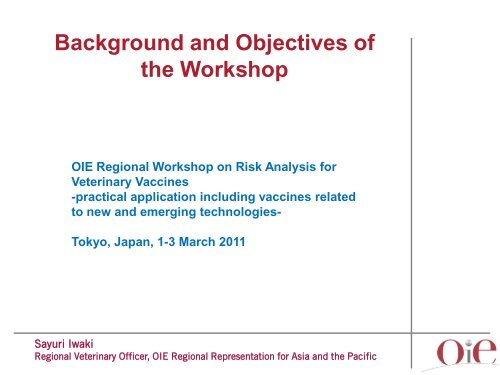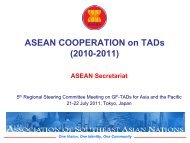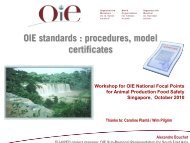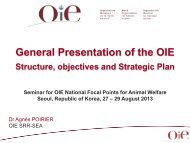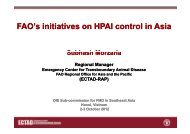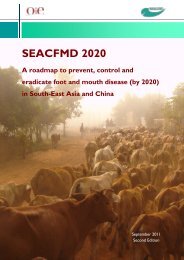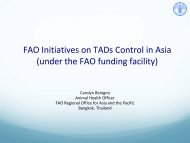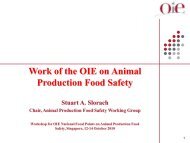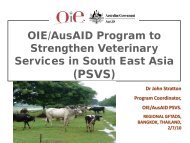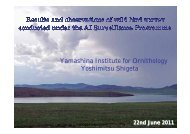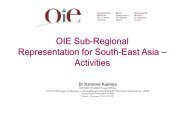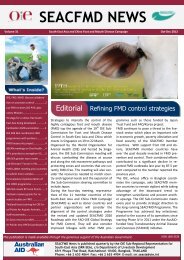ã¹ã©ã¤ã 1 - OIE Asia-Pacific
ã¹ã©ã¤ã 1 - OIE Asia-Pacific
ã¹ã©ã¤ã 1 - OIE Asia-Pacific
Create successful ePaper yourself
Turn your PDF publications into a flip-book with our unique Google optimized e-Paper software.
Background and Objectives ofthe Workshop<strong>OIE</strong> Regional Workshop on Risk Analysis forVeterinary Vaccines-practical application including vaccines relatedto new and emerging technologies-Tokyo, Japan, 1-3 March 2011Sayuri IwakiRegional Veterinary Officer, <strong>OIE</strong> Regional Representation for <strong>Asia</strong> and the <strong>Pacific</strong>
• Background information,Contents• Review of the last Workshop in Kuala Lumpur,• Expected output of this Workshop,• Future plan
Background Information
History of the Regional Workshops (1)• Since 2006, <strong>OIE</strong> <strong>Asia</strong>-<strong>Pacific</strong> has been organising aseries of regional workshops on veterinary productsunder Japan Trust Fund.• This series started in response to a request from ASEANMembers.– <strong>OIE</strong> Regional Workshop on International/RegionalHarmonization of Veterinary Medical Products (Bogor,Indonesia, 6-10 November 2006)– <strong>OIE</strong> Regional Workshop on Harmonization of VeterinaryVaccines (Pakchong, Thailand, 21-25 January 2008)– <strong>OIE</strong> Regional Workshop on Vaccine Quality and GLP in ASEANCountries (Bandung, Indonesia, 13-16 January 2009)
History of the Regional Workshops (2)• In 2009, new topic, “Risk Analysis ofVeterinary Vaccines,” was chosen andinvitation was expanded to ASEAN+3.– <strong>OIE</strong> Regional Workshop on Risk Analysis for Import,Distribution and Handling of Animal Vaccines (KualaLumpur, Malaysia, 3-5 November 2009)
<strong>OIE</strong> Regional Workshop on Risk Analysis forImport, Distribution and Handling of Animal Vaccines(Kuala Lumpur, Malaysia, 3-5 November 2009)• Objectives:‣ to provide information on registration of animal vaccinations andrisk analysis of animal vaccines, esp. for import, distribution andhandling‣ to discuss the development of standards on risk analysis ofanimal vaccines in the Region• Countries Participated: Cambodia, Indonesia, Japan, R.O.Korea, Laos, Malaysia, Myanmar, Philippines, Singapore, Thailandand Vietnam• Resource Persons: Dr Michel Lombard, <strong>OIE</strong> Expert
<strong>OIE</strong> Regional Workshop on Risk Analysis(Kuala Lumpur, Nov. 2009)From the presentation of Dr Michel LombardRisk Analysis for Animal Vaccines‣Risk Analysis for Import: First at level of the VaccineRegistration Dossier, then during Inspection of theManufacturing site‣Risk Analysis for Distribution: Transport, Customsclearance, storage and distribution to dealers.‣Risk Analysis for Handling & Use: Correct use by trainedvaccinators and vaccinovigilance
<strong>OIE</strong> Regional Workshop on Risk Analysis(Kuala Lumpur, Nov. 2009)Dr Lombard presented on<strong>OIE</strong> Terrestrial Manual Appendix 1.1.8.2“Risk Analysis for Veterinary Vaccines”Introduction1.Principles2.Manufacturing practices3.Information to be submitted when applyingfor registration in the importing country4.Category of veterinary vaccines5.Vaccinovigilance6.Risk communication
What is Vaccinovigilance?• Post licensing monitoring1. Report of adverse reactions in vaccinated animals2. Report of symptoms in animal in the vicinity3. Report of lack of efficacy4. Report of incorrect vaccine use5. Report of deficiencies in the vaccine’s manufactureHow does vaccinovigilance work?Solving the Suspected Adverse Reaction• Request further tests• Increased surveillance of the vaccine use• Recommend or require halt in vaccine sale• Recall the batch• Request return of the product to Manufacturer andreplacement or credit if already paid
<strong>OIE</strong> Regional Workshop on Risk Analysis(Kuala Lumpur, Nov. 2009)Country Presentations• Risk Analysis in NVDAL (Indonesia)• Risk Analysis in Japan (NVAL) (Quality control ofRabies vaccines as an example)• Animal Vaccine Registration and Veterinary DrugAdministration in Malaysia• Country reports (15min) from Cambodia, Korea RO,Laos, Myanmar, Philippines, Singapore, Thailand andVietnamRisk Analysis forvet vaccines isstill new areaand need furtherassistance(Lack of humanresources)• Legislation• Structure• Registration procedures• Testing• Monitoringof veterinary vaccinesInsufficient vaccinesupply,Lack of vet law,Insufficient farmercooperation
<strong>OIE</strong> Regional Workshop on Risk Analysis(Kuala Lumpur, Nov. 2009)Discussion on ASEAN activities related to vaccines• ASEAN Standards for Animal Vaccines (SalmonellaGallinarum, Leptospira and Avian Influenza)• ASEAN Register of Animal Vaccines• ASEAN Standards for GMP for Animal Vaccines• Protocol for Accreditation of ASEAN Animal VaccineTesting LaboratoriesThese documents were scheduled to be finalized at the12th Meeting of ASEAN National Focal Points on AnimalVaccines (AFPAV) in 2010
<strong>OIE</strong> Regional Workshop on Risk Analysis(Kuala Lumpur, Nov. 2009)Recommendationsof the Kuala Lumpur Workshop• Risk Analysis models for animal vaccines should bedeveloped (based on the <strong>OIE</strong> Standards) to supportvaccine quality assurance in the Region.• A regional technical workshop should be considered toenhance understanding and identify gaps.• International/Regional Organizations should beencouraged to support Regional activities on RiskAnalysis for animal vaccines.
http://www.rr-asia.oie.int/representation/programmes/programme_d/index.html
<strong>OIE</strong> Collaborating Centre• In May 2010, Japan’s National Veterinary AssayLaboratory and National Institute of Animal Health(NVAL/NIAH) were jointly designated as an <strong>OIE</strong>Collaborating Centre for Diagnosis and Control of AnimalDiseases and Related Veterinary Product Assessment in<strong>Asia</strong>.• This new joint Centre kindly agreed to start contributingto the Region by supporting this workshop.
<strong>OIE</strong> Regional Workshop onRisk Analysis for Veterinary Vaccines-practical application including vaccines related to new andemerging technologies-(Tokyo, Japan, 1-3 March 2011)• Participants: Cambodia, P.R. China, Chinese Taipei, Hong KongSAR, Indonesia, Japan, R.O. Korea, Laos, Malaysia, Mongolia,Myanmar, Philippines, Singapore, Thailand and Vietnam• Resource Persons:Dr Donna Hutching, <strong>OIE</strong> ad hoc groupDr Richard Hill, USDA-APHISDr Sam Hamilton, AustraliaNVAL/NIAH/MAFF Japan
Expected output of this Workshop
Expected output of this Workshop (1)1. Understand more about risk analysis methodologies forveterinary vaccines and identify the gap of applyingsuch methodologies to improve quality assurance ofveterinary vaccines in the region2. Understand current international discussion related tonew and emerging technologies for veterinary vaccinesand take in useful/necessary information for the region3. Share information on current situation/experience ofveterinary vaccines, especially for rapid supply, testcapability and adverse event, and discuss on what isthe weakness and how to improve in the region
Expected output of this Workshop (2)4. Share information on activities in ASEAN. (ASEANMembers will have additional discussions after theWorkshop.)5. Update information on specific topics related toveterinary vaccines (VICH, FMD in Japan, <strong>OIE</strong> VaccineBank).6. Visit <strong>OIE</strong> collaborating centre to understand theiractivities for further cooperation
Future Plan
Future PlanWorkshop for <strong>OIE</strong> National Focal Pointsfor Veterinary Products• Venue: Cambodia• Date: 28-30 June 2011• Participants: <strong>OIE</strong> National Focal Points for VeterinaryProducts of all the <strong>OIE</strong> Members in the <strong>Asia</strong>-<strong>Pacific</strong>Region
Future PlanGive us your ideas!(Discuss on the 3 rd day)• What issues should be picked up underthis programme?(e.g. Vaccination for Rabies Control, Antimicrobialresistance, etc.)• What form is preferred?Technical Workshop? Lecture Conference?Expert consultation followed by publications?


